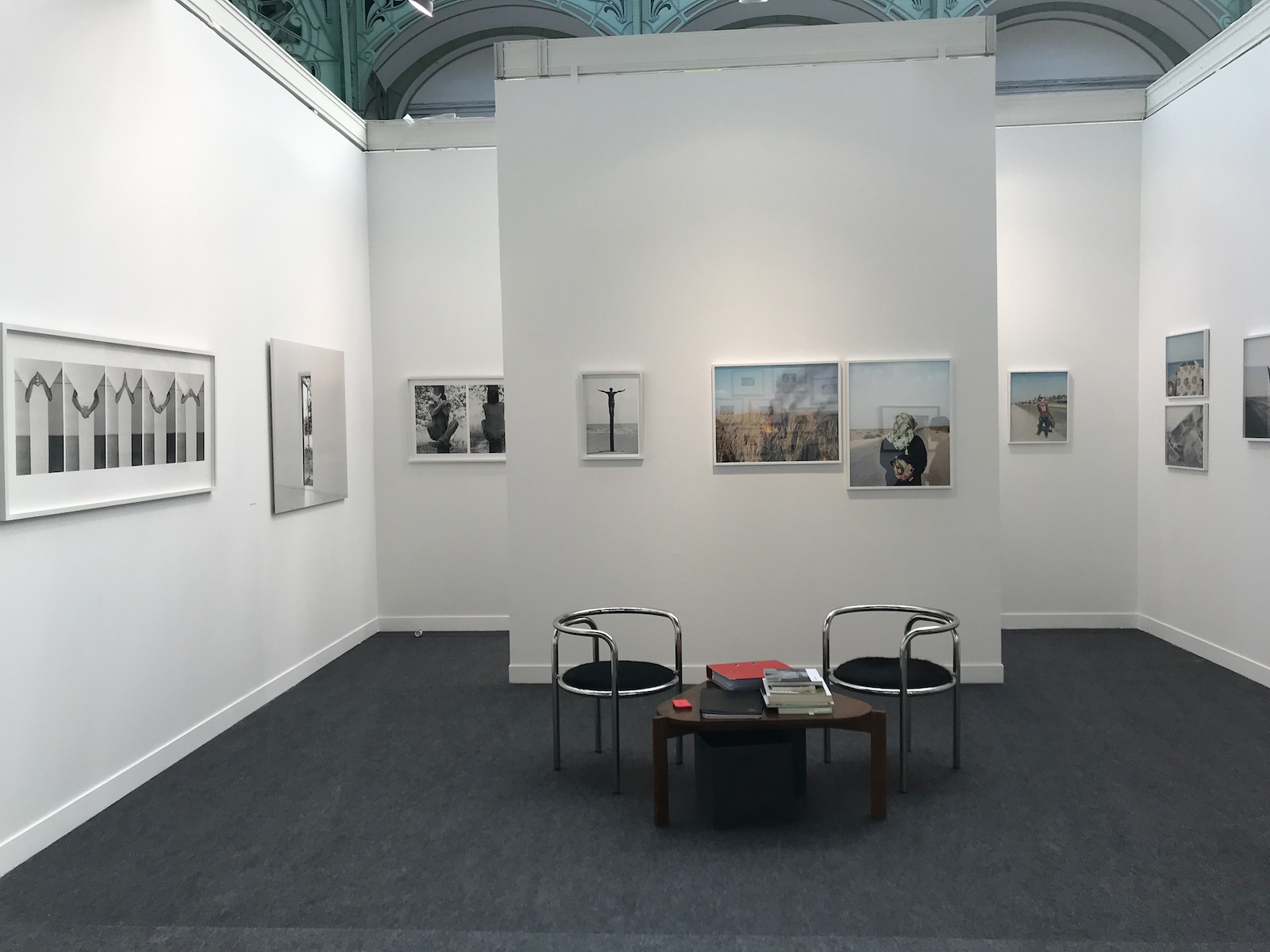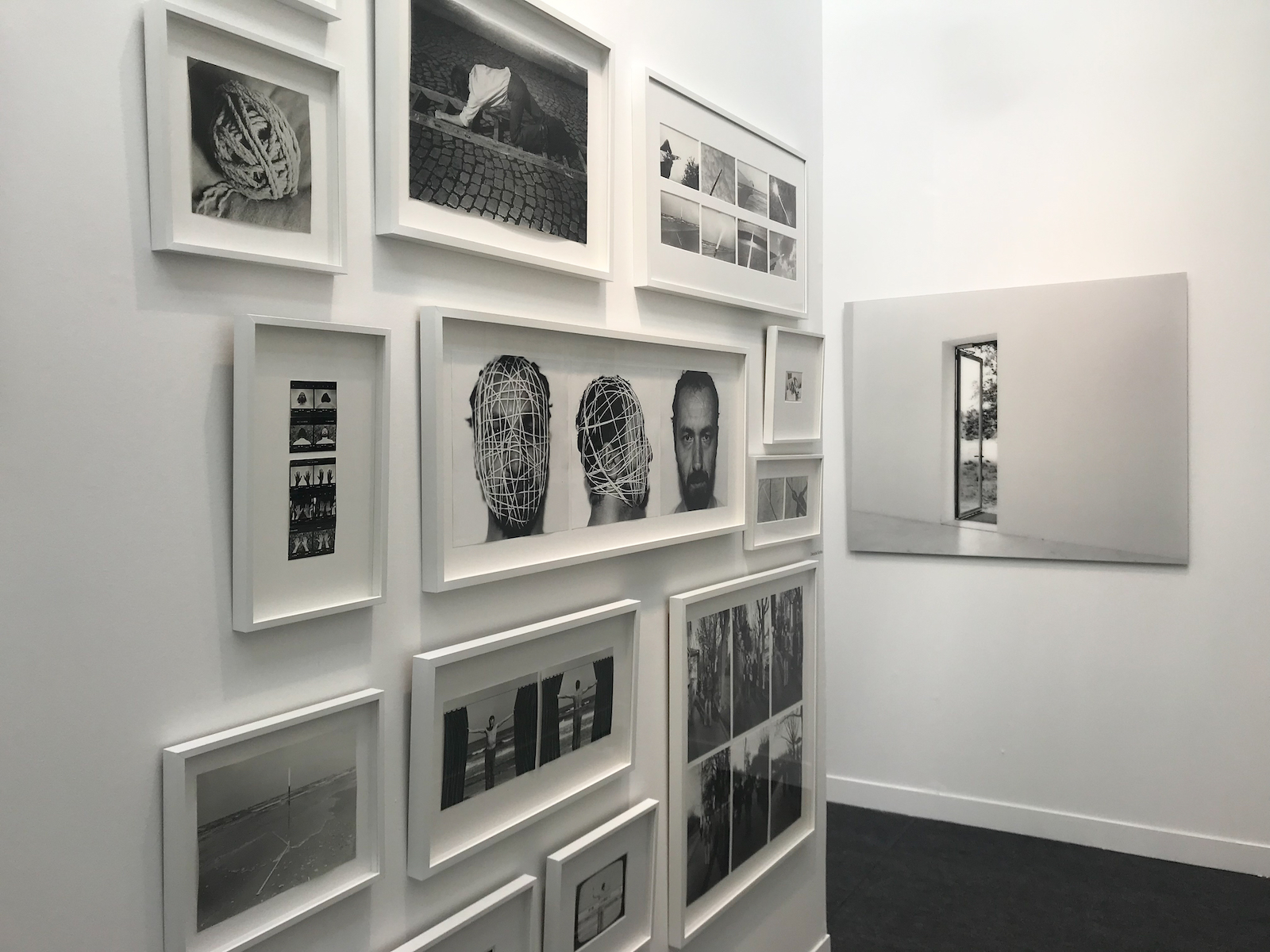Paris Photo 2019

Image: 10,5 x 16,5 cm
Frame: 28,5 x 34,5 x 2,5 cm
Omen shows an imprisoned hand by ropes, suggesting a lack of freedom of movement, equally physical and psychological. Fingers' forced immobility alludes to the artist's status under dictatorial regime.
The clew, recurring pattern in Decebal Scriba's work, reflects the idea of an initiatory journey, or even the course of existence, becoming in this photograph a premonitory sign of absurdity that occurs in the reality.
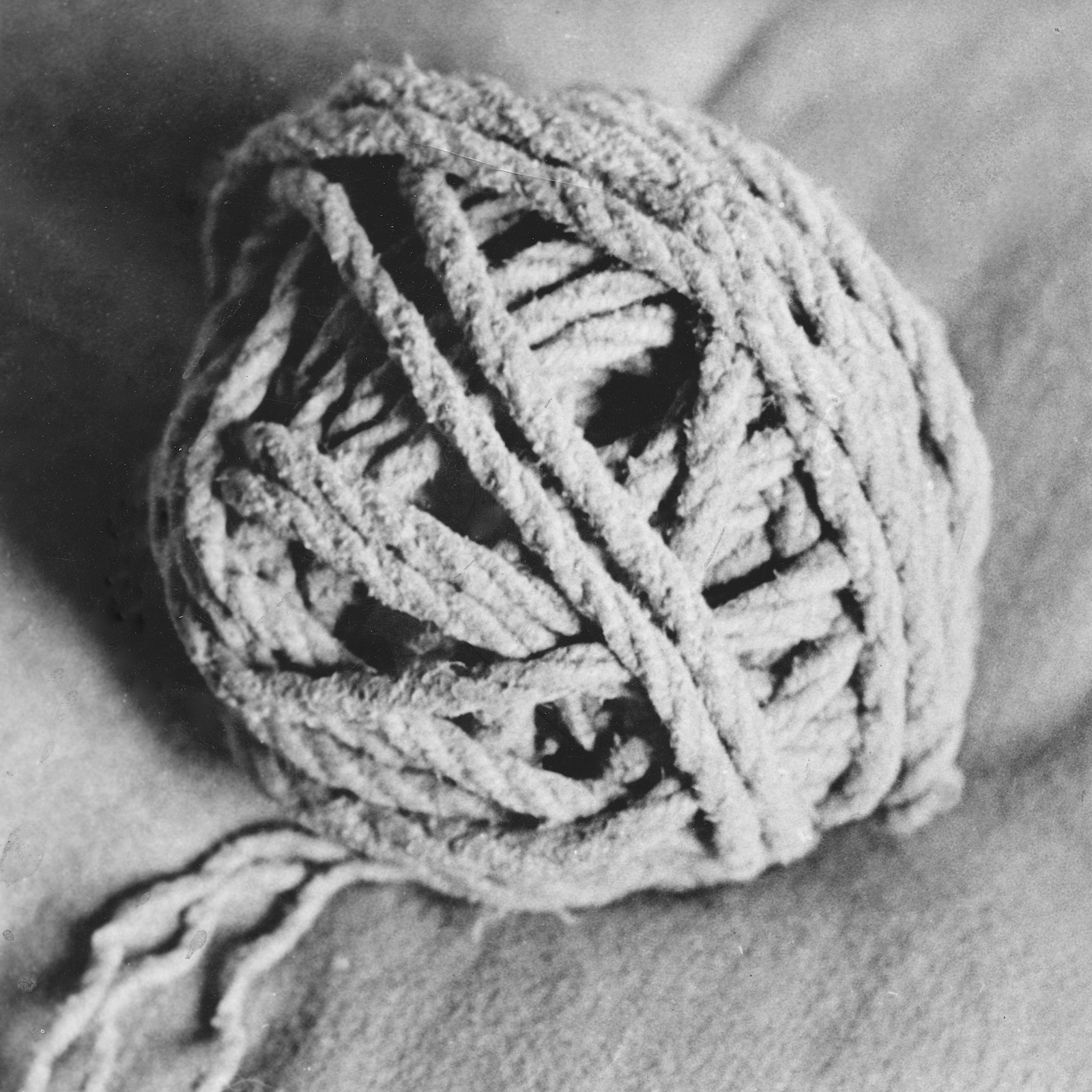
Image: 17,5 x 17,5 cm
Frame: 27 x 27 x 2,7 cm (encadré)
The clew is a recurrent pattern in Decebal Scriba's work. It takes on a strong symbolic and philosophical dimension, the rope referring to the idea of an initiatory journey, or even the course of existence. Composed of entanglements of yarn sometimes ordered, sometimes chaotic, it introduces a reflection on existential dilemmas.
This symbol is also used in drawings during state exhibitions and, under the guise of sobriety and innocence, allows the artist to escape the risk of censorship.

Image: 30 x 45 cm
Frame: 43 x 57,5 x 3 cm
Action II presents in a conceptual and performative work, an absurd situation where a man is climbing a ladder placed on the floor. This situation, to all appearances humorous is intended to reveal the absurdity of a system constraining artists to immobility.
Nowadays named performances, this type of artwork was called actions, which has undeniably a more powerful political connotation.

Image: 1 3/4 x 3 inches (each)
Frame: 15 x 9 x 1 inch
Relational Attitudes is a pioneer project in Decebal Scriba’s work, announcing the premises of a conceptual dimension which systematically appears in his artworks. By staging attitudes and meaningful gestures, the artist appeals either to an acceptation of aspects of reality, or a rejection just before it occurs a conquest and a relief relating to these aspects.
A photocopy of this work is archived in the Institut für Moderne Kunst in Nürnberg, belonging to a correspondence between the artist and one of his German counterpart, being part of “mail art”.
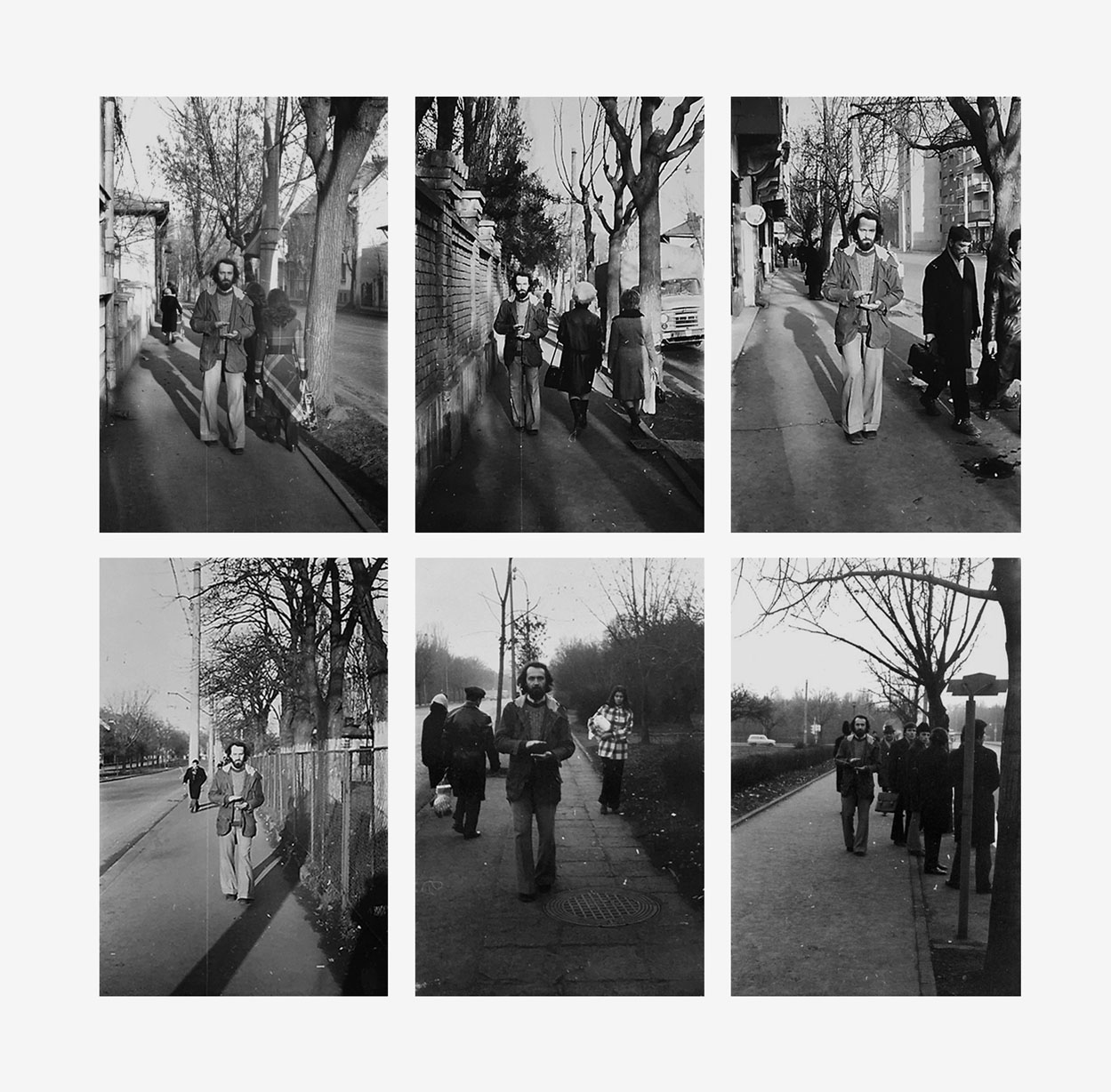
Image: 30 x 20 cm chaque
The Gift is a performance executed in 1973 and 1974 in the streets of Bucharest in which the artist, while evolving in the city holding an imaginary object, attempts to enter into communication with a potential audience. It is part of a reflection already initiated where the symbolism of the posture is explored, becoming ritual, essential or universal. Due to an oppressive policy and a climate of constant denunciations, the expected contact is missed and the experience punctuated by suspicious looks. It is immortalized by photographs, of which this last version of presentation enables to restore the atmosphere of this period, acting by this documentary dimension like a real testimony of the time.

Image: 2,75 x 3,9 inch
Frame: 11,4 x 12,6 x 1 inch
The "Masks"series is marked by a strong political dimension, staging symbolically the constraints generated against Romanian intellectuals in times of dictatorship, especially artists.

Black and white gelatin silver prints - Triptych
Image: 30 x 30 cm (each)
Frame: 42 x 104 x 3 cm
The "Masks" series is marked by a strong political dimension, staging symbolically the constraints generated against Romanian intellectuals in times of dictatorship, especially artists.
Mask # 2 suggests a reflection about the final image, here by the marks left on the skin after the removal of a tightly wrapped string. This political work, though without being a program of dissidence, evokes the muzzling, the oppression undergone during a period of censorship and extreme surveillance.

Vintage gelatin silver prints (photo stripes)
Image: 1 3/8 x 1 1/2 inches (each)
Frame: 9,6 x 10,8 x 1 inch
The "Masks" series is marked by a strong political dimension, staging symbolically the constraints generated against Romanian intellectuals in times of dictatorship, especially artists.

8 vintage black and white gelatin silver prints
Image: 4,2 x 6,5 inch each
Frame: 42 x 82 x 3 cm
The Labyrinth photographs, from the Mirror series, capture an intervention on the seaside, and act as a philosophical reflection around the concept of reality. Like a labyrinth, this notion of reality can take a multitude of paths; there is a global picture of reality in accordance with a supposedly established definition, becoming nevertheless more and more complex and elusive as soon as our common conventions are reconsidered, calling into question its very existence.

vintage black and white gelatin sliver print
Image: 18,5 x 25 cm
Frame: 32,3 x 26,4 x 2,5 cm
The Labyrinth photographs, from the Mirror series, capture an intervention on the seaside, and act as a philosophical reflection around the concept of reality. Like a labyrinth, this notion of reality can take a multitude of paths; there is a global picture of reality in accordance with a supposedly established definition, becoming nevertheless more and more complex and elusive as soon as our common conventions are reconsidered, calling into question its very existence.

Image: 7 x 9,6 inch
Frame: 11,6 x 14 x 1 inch
The Labyrinth (horizon) photograph, from the Mirror series, capture an intervention on the seaside, and act as a philosophical reflection around the concept of reality. Like a labyrinth, this notion of reality can take a multitude of paths; there is a global picture of reality in accordance with a supposedly established definition, becoming nevertheless more and more complex and elusive as soon as our common conventions are reconsidered, calling into question its very existence.
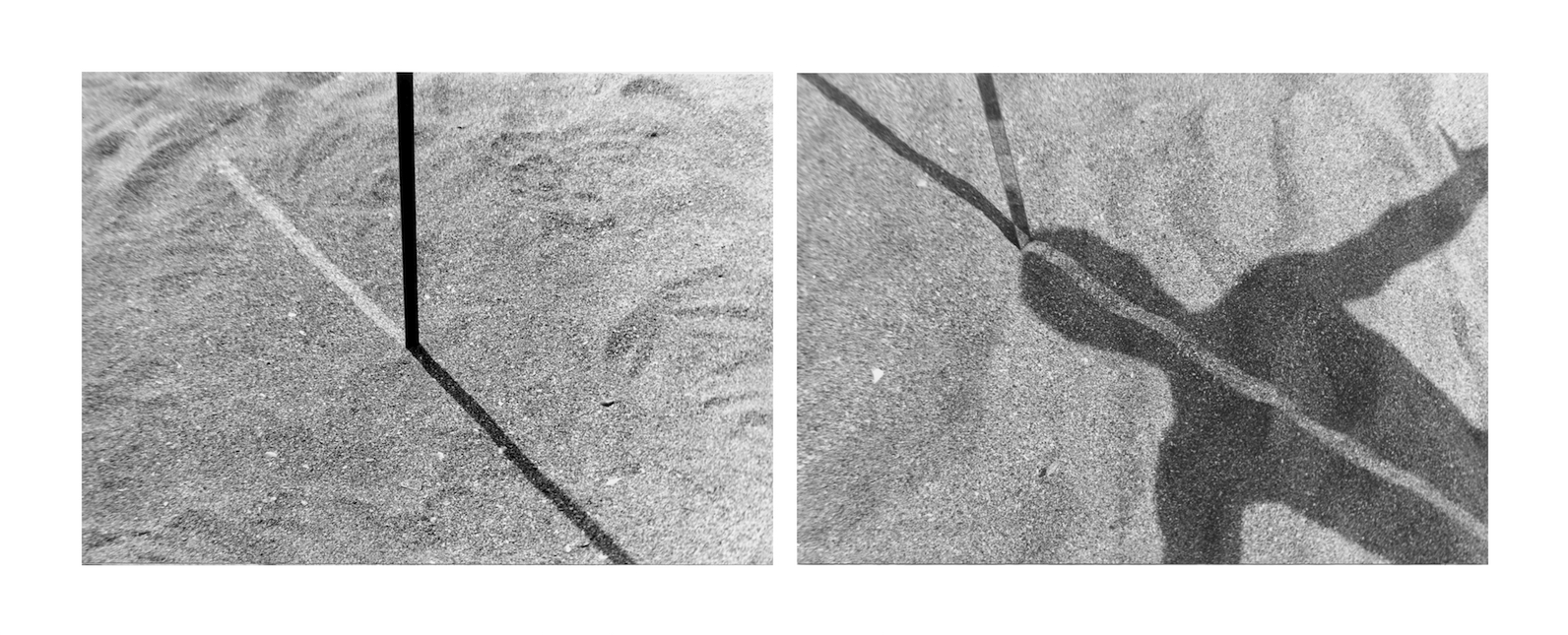
Image: 4,3 x 6,1 inch (each)
Frame: 8,5 x 17 x 1 inch
Axis #01 témoigne de la manière dont la dimension conceptuelle inhérente au travail de Decebal peut transformer, compléter, déconstruire aussi bien que reconstruire le signifiant au sein de l’œuvre. Cette dématérialisation qui s’opère vient perturber l’espace et les éléments s’y trouvant, amenant ainsi une réflexion philosophique autour de la notion de réalité.

Image: 4,7 x 6,7 inch
Frame: 11,2 x 13,5 x 1 inch
Performance project is an attempt to make a video, composed of a gestures’ series, pursuing a reflection about body language, also visible in The gift or Body sign series.
This project never ended due to the shortage of video equipment within a context of political austerity. Nevertheless, it shows the multiplicity of devices surrounding Decebal Scriba’s performance.

16,5 x 23 cm (each)
Curtain #2 (performance project) is a photograph of a performance, in which the artist intervened retrospectively. It goes along with a performance and intervention series realized on the seaside, exploring gestures symbolic and the connection with reality. In this photograph, painted curtains come on the top of the represented action, creating the illusion, both symbolical and political, of opening or closing on the horizon.

Image: 65 x 162 cm
Frame: 69 x 166,5 x 3 cm
With Signs (body work), Decebal Scriba reinvests the language of postures already undertaken in other series. Here, it acquires a ritual dimension, while echoing the socio-cultural context of Romania in the 1970s. The gestures, in a sort of reinvented sign language, refer to attitudes adopted during the Romanian communist regime: passivity, consolation, acceptance... Accordingly, the column hides the body to focus attention on the hands, vehicles of emotion and silent speech when expression was constrained.
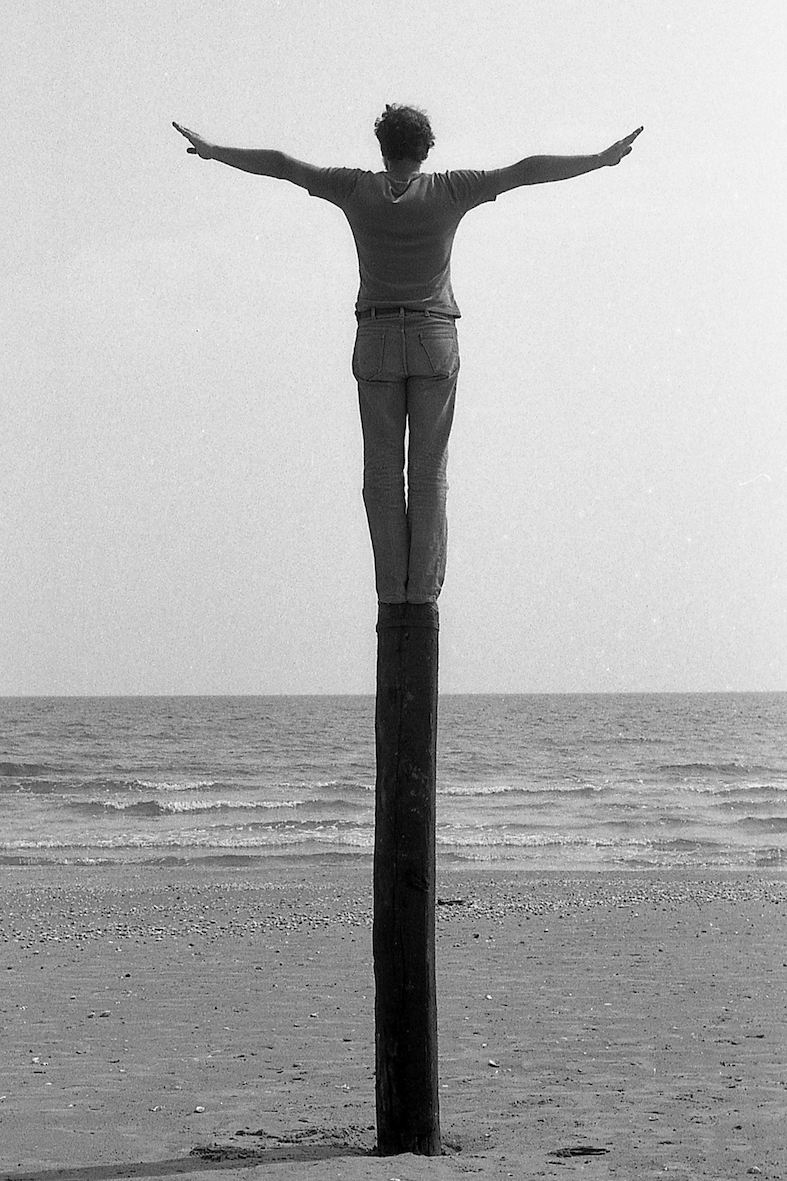
Black and white gelatin silver print
Image: 17,7 x 11, 8 inch
Body Sign # 1 belongs to a series of photographs from a performance featuring different static positions. It is part of a reflection on body postures, also visible in The Gift or Body Sign #2 and reflects the actionism of the 80s. Currently named performances, this type of artistic interventions were then called "actions", term with an undeniable stronger political connotation.
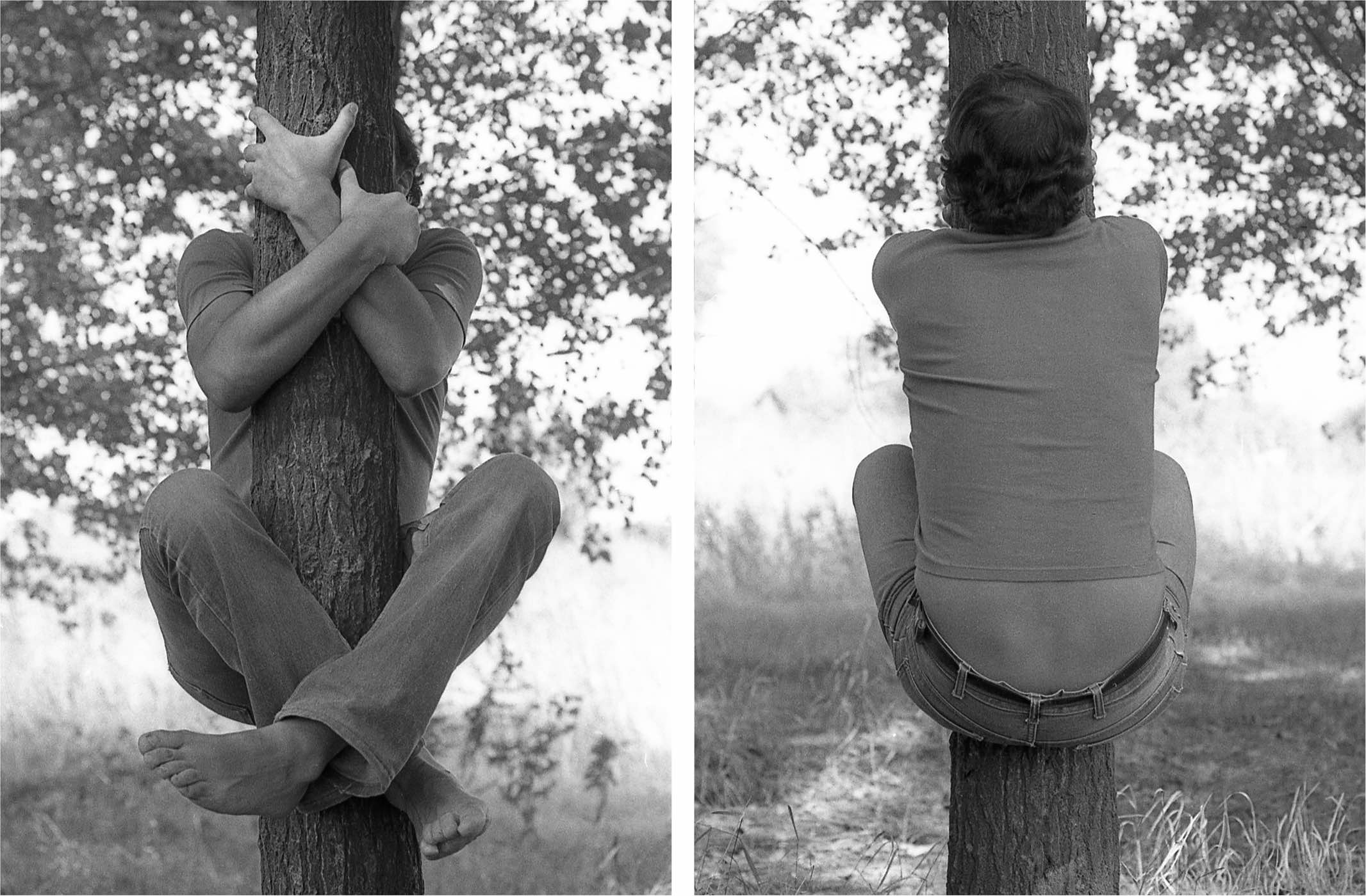
archival pigment print on Hahnemühle Photo Rag Baryta
Image: 60 x 82 cm
Paper: 62,5 x 90 cm
Frame: 62,5 x 90 x 3 cm
Body Sign #2 is part of a photography's series from a performance, staging different static positions. It has to be seen in a reflection about body postures, also presented in The gift or Body sign #1, and exhibits the actionism in the 1980s. Nowadays named performances, this type of artwork was called actions, which has undeniably a more powerful political connotation.

Inkjet Print
Image: 36 x 54 inches
Paper: 36 x 53,9 inches
Since 2012, Seton Smith has begun taking photographs of houses in different areas within the United States. Using black and white, and increasing focus sharpness, she slightly modifies her photography technique to produce works in the continuity of her endeavour to decode elements of power in architecture.
According to her, houses and more generally architecture shape individuals. Conversely, buildings, private housing or public institutions embody fragments of life’s marks and memories of human existence.
In these large series of photographs, conceptualised as a road-trip across the American territory, it is all the individual and global history of the country which is elucidated and which can be felt in relation to these solitary houses.
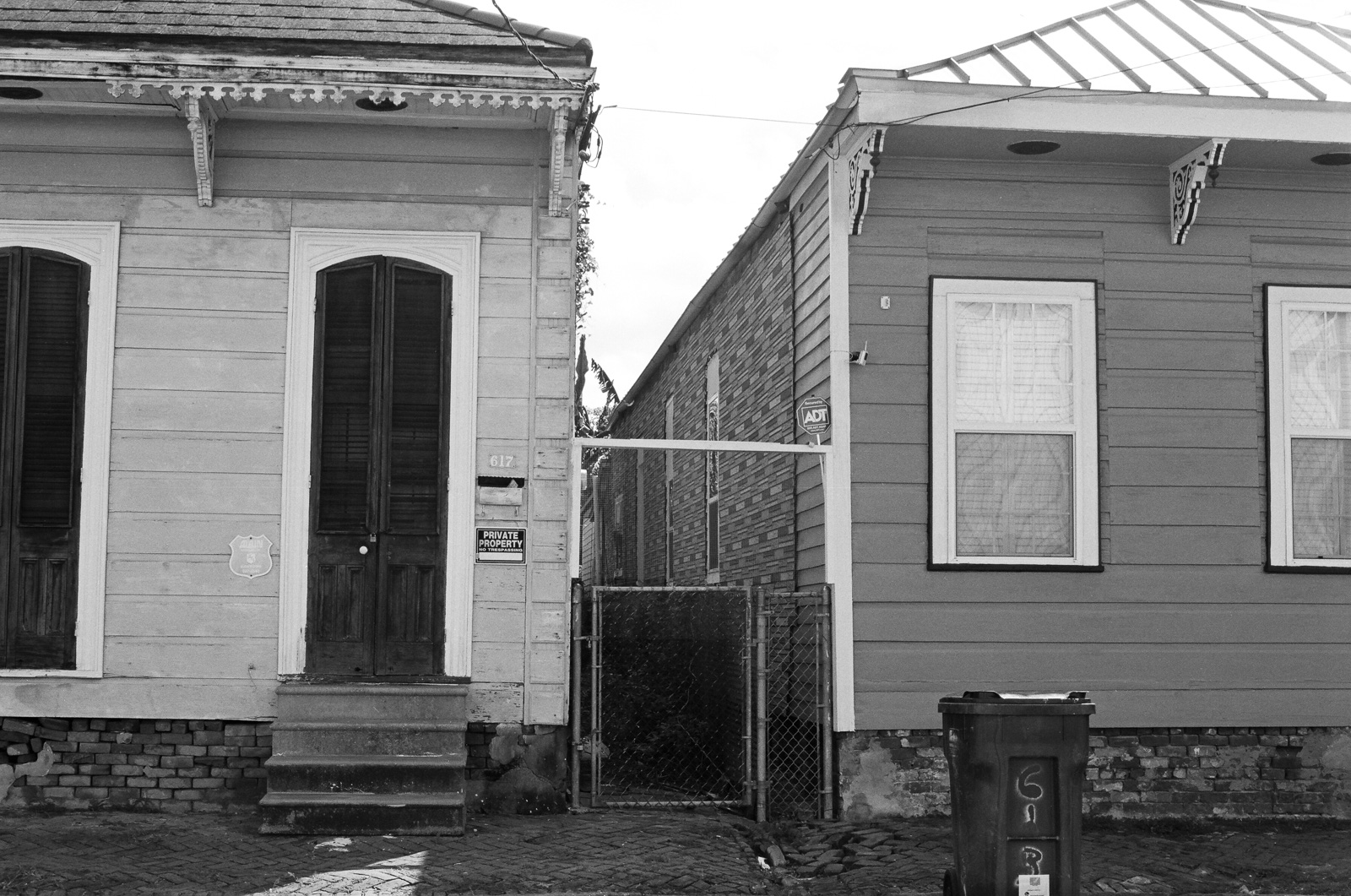
archival pigment print
Image: 16 x 24"
Since 2012, Seton Smith has begun taking photographs of houses in different areas within the United States. Using black and white, and increasing focus sharpness, she slightly modifies her photography technique to produce works in the continuity of her endeavour to decode elements of power in architecture.
According to her, houses and more generally architecture shape individuals. Conversely, buildings, private housing or public institutions embody fragments of life’s marks and memories of human existence.
In these large series of photographs, conceptualised as a road-trip across the American territory, it is all the individual and global history of the country which is elucidated and which can be felt in relation to these solitary houses.

Image: 38,2 x 47,2 inches
Paper: 38,2 x 47,2 inches
This photograph of a room in the Insel Hombroich Museum, located near Dusseldorf is in line with the architectural minimalism that characterizes Seton Smith’s work.
Perspective drives the eye towards the outside, contrasting with the luminous and seemingly empty inside of the room.
Phantasmagorical testimony of an absence, this photograph invites the viewer to project themselves into the universe of memory of the works and to penetrate the image in order to sense their presence in counterpoint.

Image: 38,1 x 47,2 inches
Paper: 38,1 x 47,2 inches
This photograph of a room in the Insel Hombroich Museum, located near Dusseldorf is in line with the architectural minimalism that characterizes Seton Smith’s work.
Perspective drives the eye towards the outside, contrasting with the luminous and seemingly empty inside of the room.
Phantasmagorical testimony of an absence, this photograph invites the viewer to project themselves into the universe of memory of the works and to penetrate the image in order to sense their presence in counterpoint.
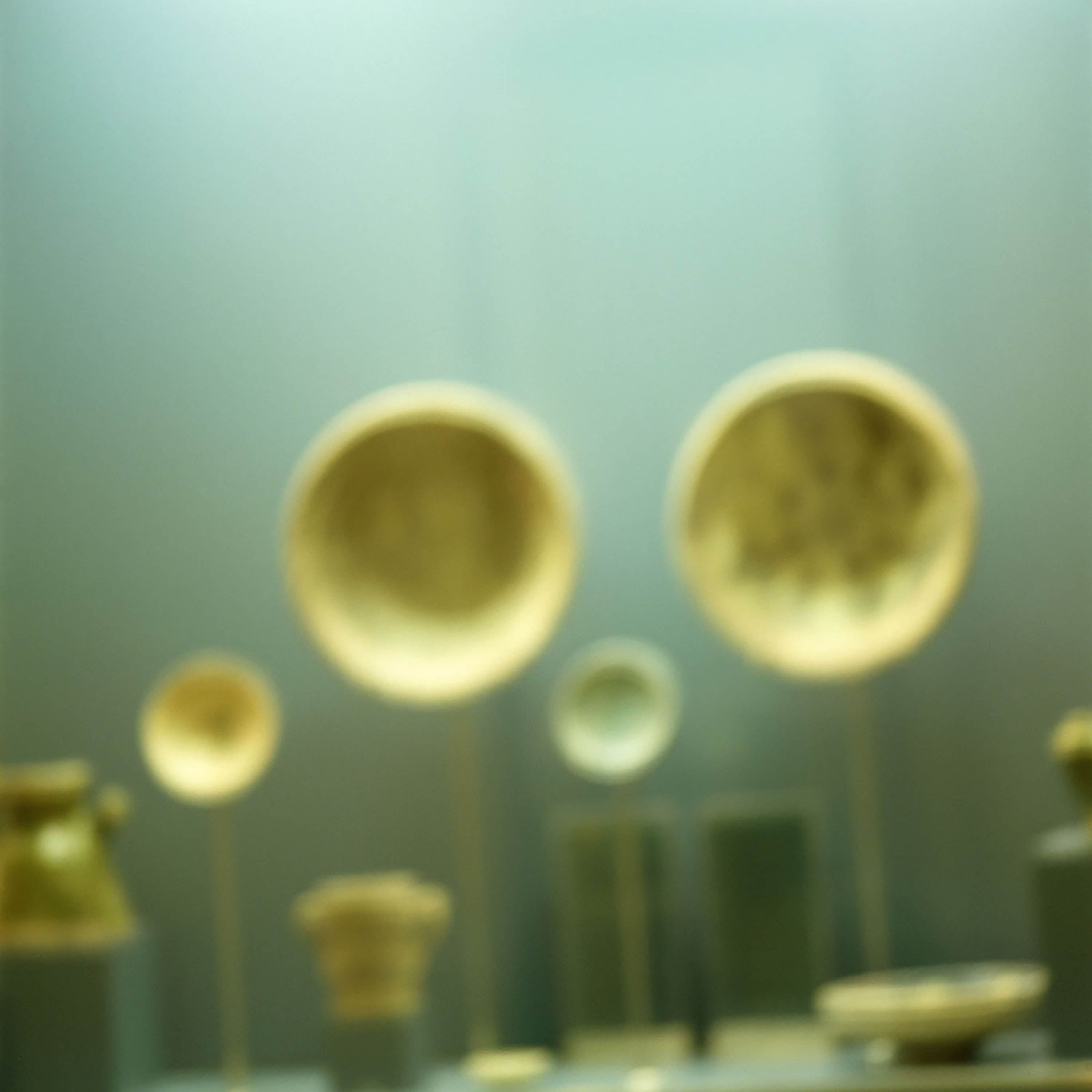
Image: 23,6 x 23,6 inches
Paper: 23,6 x 23,6 inches
Seton Smith has taken many photographs of museum interiors. In Blue Ground With Stone, it is archaeological elements located in Italy that interest the artist. This piece of art is typical of her work and takes the opposite stance of museum photographs traditionally focused on the promotion of artworks. Manipulating blurring focus and close perspective, the artist produces an image close to a monochrome which dismantles customary structures. We cannot embrace what is pictured and the artwork’s main stake is not the object in itself but the sentiment extracted from its shot. She confronts the viewer to its own representation and questions the notion of space and artwork integrated in the museum.
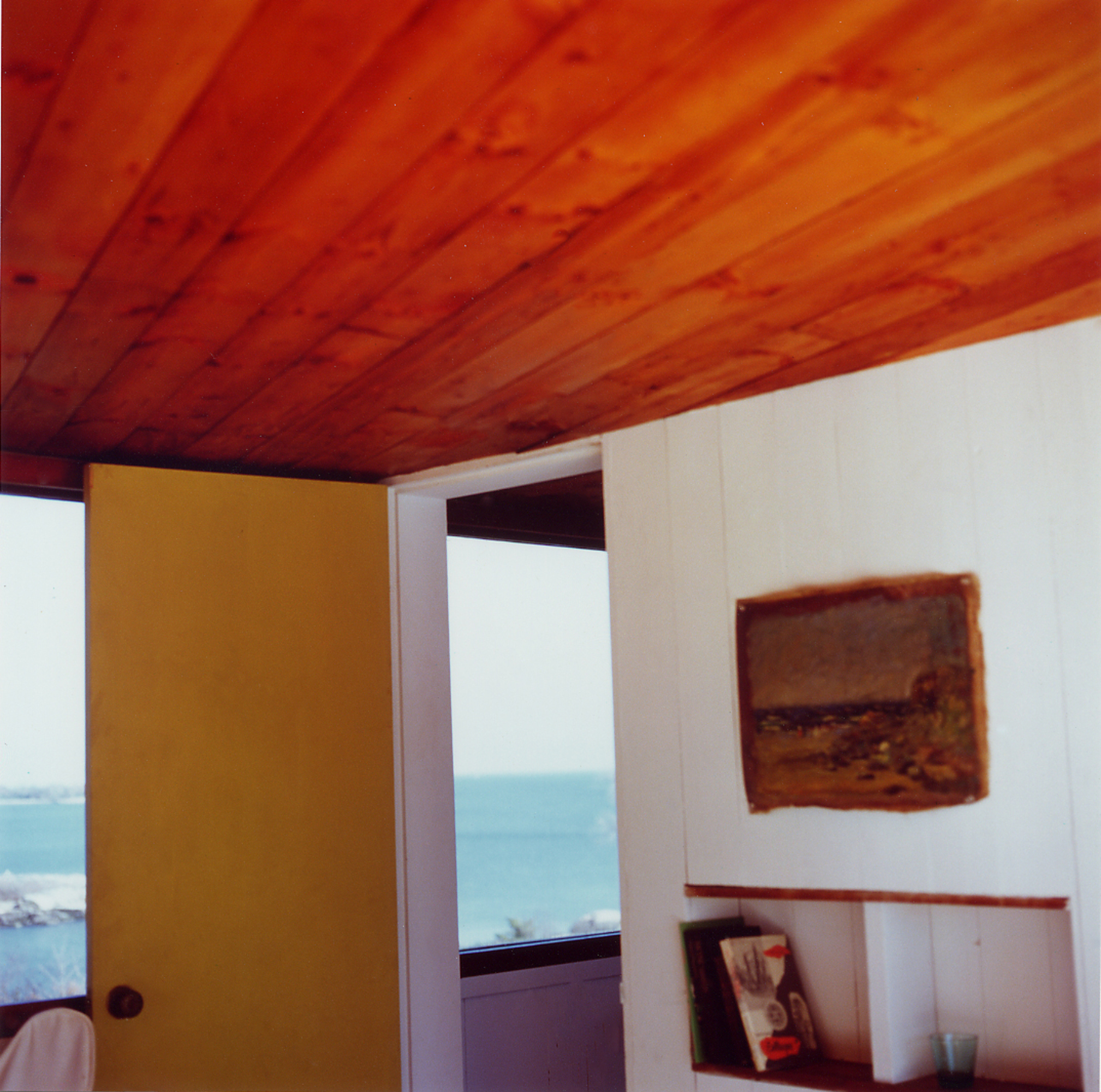
Chromogenic print
Image: 48 x 48 inches
Drawn and made by Tony Smith in 1951, this Guest House is a private property located in Guilford, Connecticut. Invited coincidentally in this house, Seton Smith was marked by this encounter with her father’s architectural minimalism. Hence, she made a series of four photographs named Guest House. Composed of bedrooms at each end, a bathroom and a central kitchen resting on pylons overhanging the Long Island Sound, this house represents the efficiency of modernism through its sober and humble design. Moreover, the view on the estuary fills with life the place, which appears as perched within space. Relying on this architectural minimalism, she occults it through the perspective, as a way to play with her familial architectural heritage.
Exhibitions:
- Kiki Smith, Seton Smith, Tony Smith, Kunstmuseum, Vaduz, Liechtenstein, 2013
- Kiki Smith, Seton Smith, Tony Smith, Les Abattoirs, Toulouse, France, 2013
- Kiki Smith, Seton Smith, Tony Smith, Bielefeld Kunsthalle, Germany, 2012
- Winston Wachter Gallery, Seattle, Etats-Unis, 2007
Bibliography:
- FRANGNE Pierre Henry and LIMIDO Patricia, Les inventions photographiques du paysage, presses universitaires de Rennes, 2016, p. 28
- MESCHEDE Friedrich (HG.), Kiki Smith, Seton Smith, Tony Smith, Bielefeld Kunsthalle, Bielefeld : Kerber Christof Verlag, september 2012, p.50
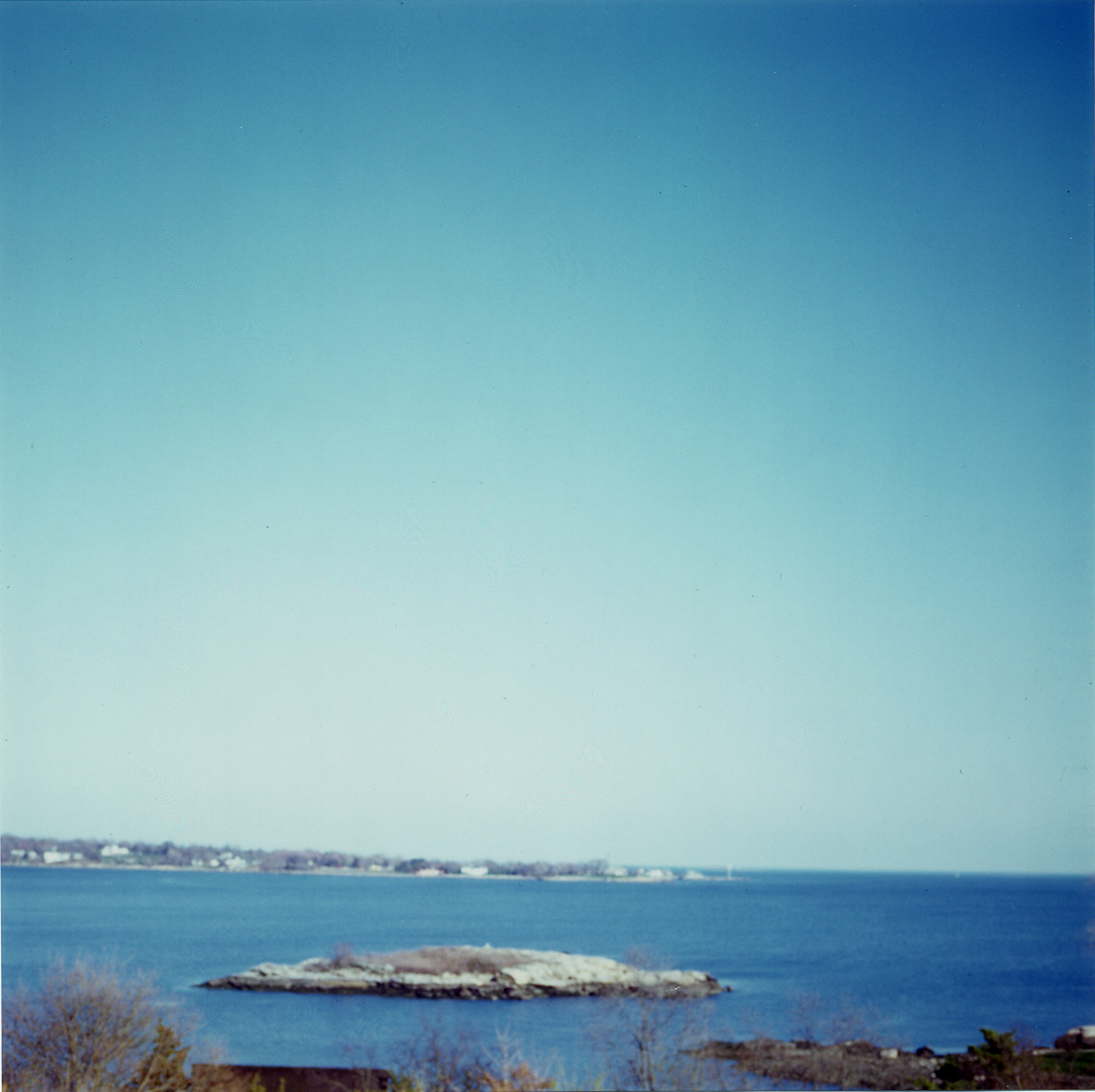
Chromogenic print
Image: 48 x 48 inches
Drawn and made by Tony Smith in 1951, this Guest House is a private property located in Guilford, Connecticut. Invited coincidentally in this house, Seton Smith was marked by this encounter with her father’s architectural minimalism. Hence, she made a series of four photographs named Guest House. Composed of bedrooms at each end, a bathroom and a central kitchen resting on pylons overhanging the Long Island Sound, this house represents the efficiency of modernism through its sober and humble design. Moreover, the view on the estuary fills with life the place, which appears as perched within space. Relying on this architectural minimalism, she occults it through the perspective, as a way to play with her familial architectural heritage.
Exhibitions:
- Kiki Smith, Seton Smith, Tony Smith, Kunstmuseum, Vaduz, Liechtenstein, 2013
- Kiki Smith, Seton Smith, Tony Smith, Les Abattoirs, Toulouse, France, 2013
- Kiki Smith, Seton Smith, Tony Smith, Bielefeld Kunsthalle, Germany, 2012
- Winston Wachter Gallery, Seattle, Etats-Unis, 2007
Bibliographie:
- FRANGNE Pierre Henry et LIMIDO Patricia, Les inventions photographiques du paysage, presses universitaires de Rennes, 2016, p. 28
- MESCHEDE Friedrich (HG.), Kiki Smith, Seton Smith, Tony Smith, Bielefeld Kunsthalle, Bielefeld : Kerber Christof Verlag, septembre 2012, p.52
